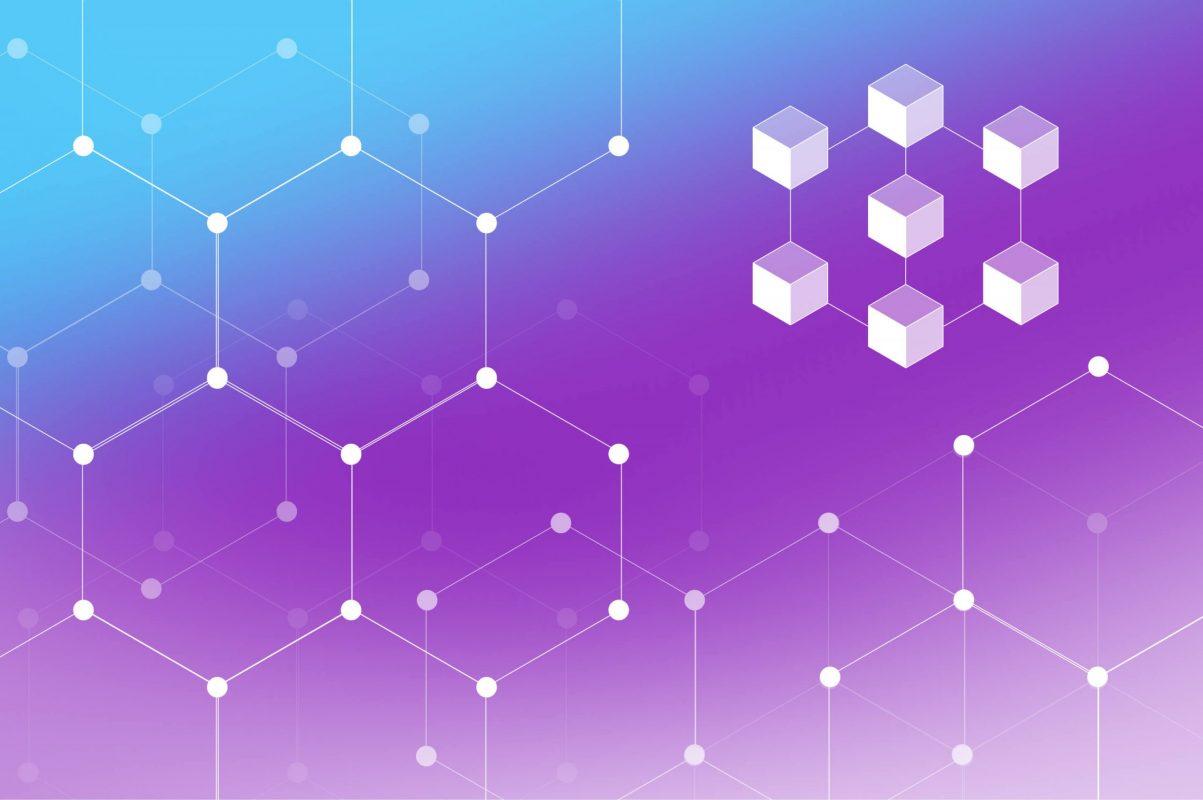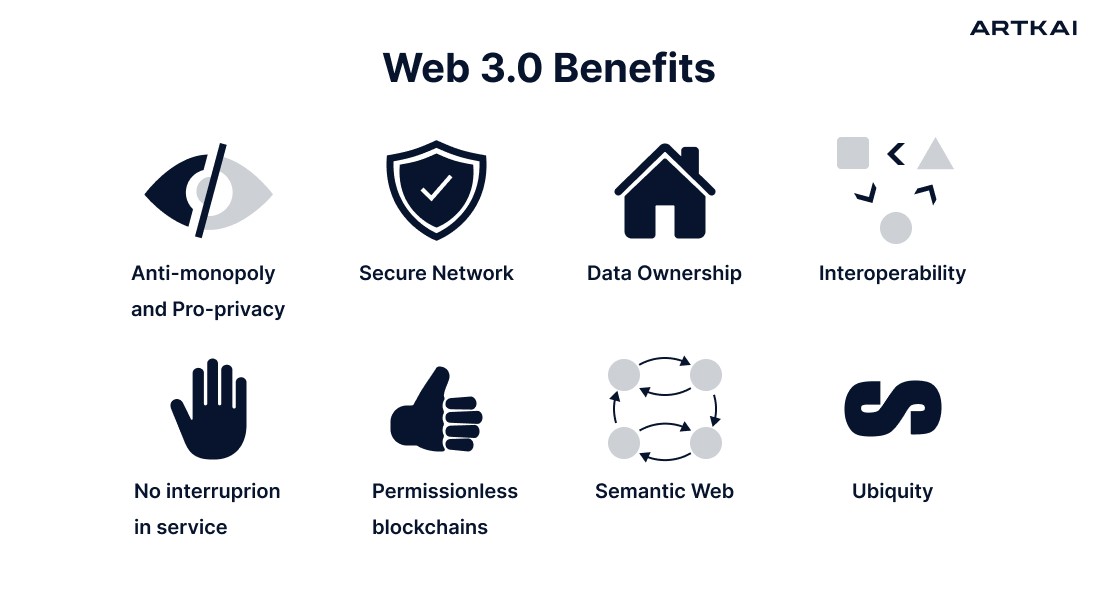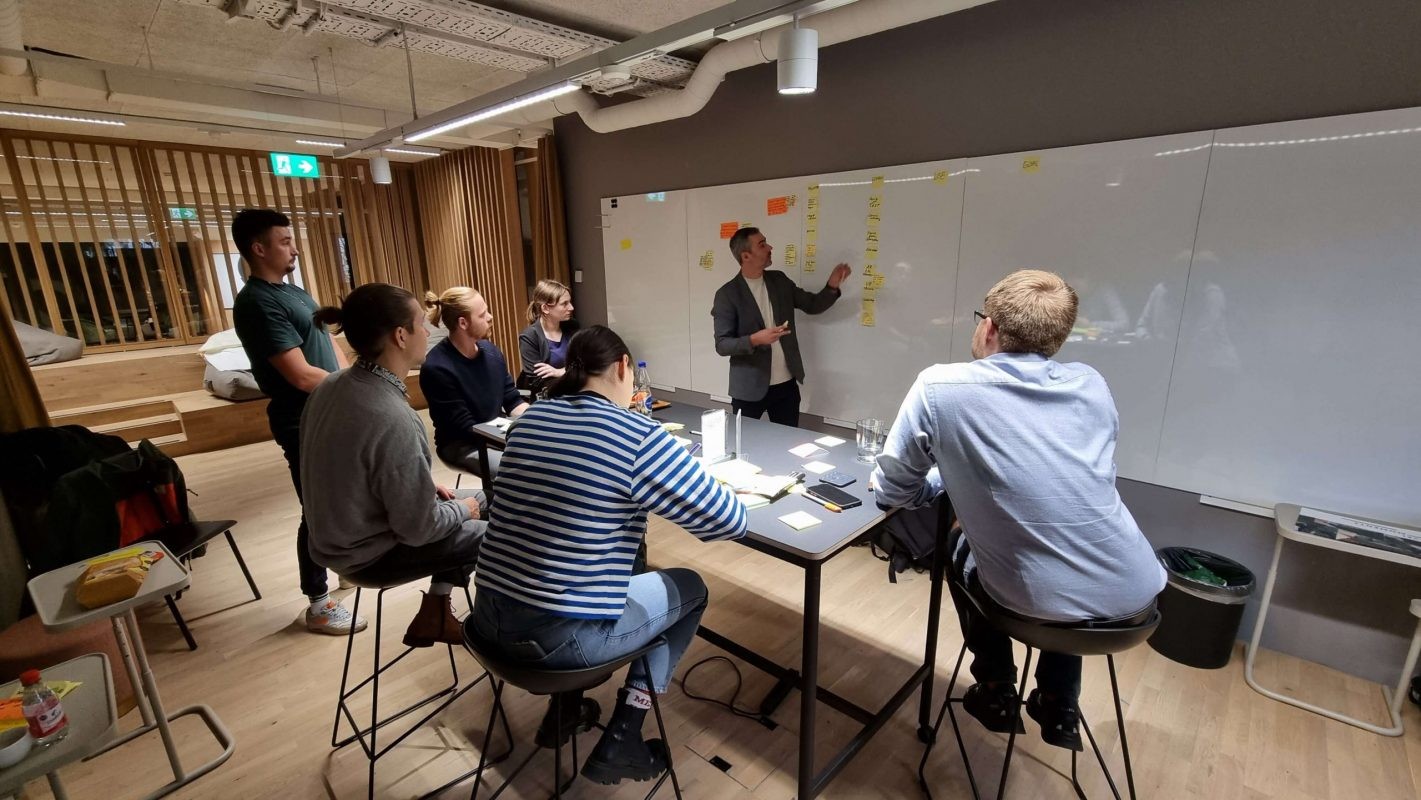
May 27, 2023
Web 3.0: Application and Use Cases
The Internet keeps evolving; today, the digital community is amid the Web2 to Web3 transition. The first Internet use efforts meant static, non-responsive content delivered to passive consumers. Web2 emerged as a more innovative, reciprocal form presupposing more active user engagement and giving opportunities for user content generation.
However, even a more progressive Web2 didn’t allow user control over data, with several tech giants monopolizing data storage/ownership and creating a multi-billion-dollar scheme for user profiling. Today, users enjoy little privacy online, with their preferences tracked and their data sold to large-scale marketers and advertisers.

Web3 emerged to solve this challenge and give control back to the user. It is a network of fully decentralized apps and platforms allowing ultimate user privacy and freedom online. This promise has ignited user interest in Web3 products, causing the Web3 market to exceed $3 billion in 2021, with rough estimates of its worth reaching $23 billion by 2028. The CAGR of 43%+ speaks for Web3’s popularity better than a thousand words. So, one thing is for sure: Web3 is here to stay, and you can ride the wave of its booming popularity by joining the market with innovative, demanded dApps. Here we examine the Web3 market landscape and discuss a range of Web3 app use cases you can consider for your next business project.
Web3 vs. Web2: Key Distinctions
What makes Web2 and Web3 apps different? Here is an outline of key breakpoints you should note in the Web2 to Web3 evolution.
Web2
- Characterized by centralized data storage and ownership.
- Access to apps requires much personal data from users.
- Greater computational resources are involved because of numerous third parties’ engagement.
- Centralized infrastructure with oversight and approval of authorized users.
- Censorship.
- A high risk of a single point of failure because of centralized data storage.
Web3
- Decentralized data storage and data verification by distributed nodes.
- Easy access with minimal user data input.
- Lower computational resources are needed due to the absence of intermediaries.
- Decentralized blockchain infrastructures with multiple nodes and networks.
- No censorship.
- No single point of failure in a decentralized structure.

What Are the Perks Offered by Web3?
Web3 dApps offer a realm of advantages to users and business owners, mainly due to their blockchain-based nature. The perks you’re sure to appreciate are:
- Zero server risks. We’ve all experienced dreadful app downtimes because of server failures or maintenance. These problems are impossible in Web3, as there is no physical or cloud server to store your app’s core architecture. Everything is stored on a blockchain that never stops or does the maintenance work.
- Superior security. Blockchain technology is immutable overall, thus posing minimal security risks to its users. You can store or move your assets on-chain or between different blockchains using smart contracts, knowing that they are always intact.
- User control and data ownership. The decentralization of dApp architecture shifts control over data from corporations to individuals. You can stay private on the blockchain if you want to, without sharing your online preferences or habits with third parties.
- Accessibility. Blockchain has a looser stance of numerous user restrictions and authorization requirements that limit access to many Web2 apps and resources. You can quickly register in a dApp with minimal data input, enjoying top-quality services with no friction.
- No intermediaries. The best thing about Web3 is that it removes the intermediary oversight from the digital app use process. Financial transactions become way more affordable without third-party commissions, and you always know there’s no authoritative oversight.

Best Examples of Web3 Applications in the Real World
With the rise of hype around Web3 crypto projects, developers have quickly captured the potential of the new digital product category and have launched numerous dApps using Solana Web3.js or Ether.js frameworks. Here are some business ideas on what’s trending right now and how to access Web3 market.
Metaverse/Metaspace
Metaverses are the best use case for Web3 technology today. Metaverses have offered an alternative world where people can build digital analogs of their physical life. In simple words, a metaverse or metaspace is a virtual world in which people can buy land, own a business, shop for food and clothing, and do anything else they do in reality. Thus, metaverses are gaining more popularity as they open a gateway to a realm of digital experiences non-achievable in our natural world.
The most popular examples of such projects are Decentraland and Sandbox. Users can link their crypto wallets to these metaverses and buy the needed assets in virtual worlds, living a happy, diverse life in the virtual space. This niche also promises immense profits for early adopters, as you can buy land in a quickly developing metaverse for further rental or business activities.
DeFi
Decentralized finance is one of the major use cases for Web3, giving users a unique opportunity to enjoy highly secure and borderless money transactions with low fees. Many DeFi solutions in the modern market, from e-wallets to payment gateways, are used for immediate and low-commission transactions between parties based on smart contract functionality.
Some illustrative examples of DeFi apps are Colony Lab (an Avalanche-based community-driven fund), Aave (a decentralized finance platform covering many transactional needs), and PancakeSwap (a DEX allowing p2p transactions of value among participants).
Social Media
The major change in Web2 occurred with the advent of social media, making users active co-producers of content. Web3 also can’t do without social networks, as people are social creatures and seek platforms for sharing content, communicating with fellow thinkers, and building communities.
Notably, many well-established social media have shifted to Web3. For instance, Facebook changed its name to Meta and embarked on metaverse creation. Still, Facebook follows a centralized model of user data storage and has been repeatedly involved in scandals about selling or manipulating user data. Thus, it can’t be regarded as Web3 social media in any way.
Projects that have taken a step ahead in genuine decentralization are DSCVR (a Dfinity blockchain-based social network) and Only1 (an NFT-powered social platform on Solana). The Subsocial project – a decentralized social finance platform – can also be included in the list as a product made at the intersection of social media and financial transactions.
Gaming
Web3 has given a realm of possibilities for the transformation of traditional gaming. It would be fair to say that the gaming market used to be mature and profitable even before the advent of Web3, but Web3 added the P2E component to the gaming experience. NFT P2E games have allowed gamers to earn real money by playing games instead of paying the game producer for in-game assets and premium-level armor.
The list of Web3 games is pretty huge, as the industry develops lightning-fast. Still, some world-class leaders have already emerged, like Skyweaver (a Polygon-based NFT card game with animation on par with that of usual games), Guild of Guardians (a breathtaking RPG running on Immutable X), Illuvium (a virtual game populated by fantasy creatures), and Axes Metaverse (a Web3 product of Azur Games, a well-known name in the gaming sector).
Privacy & Data Management
Oracles play a major role in this Web3 use case. These privacy and data management dApps were created to address the cross-chain friction of the blockchain world, as well as solve the challenge of bringing off-chain data to the blockchain for smart contract execution. This sector already has many well-known Web3 projects, with Chainlink, Band Protocol, DIA, Pyth, and Gravity topping the list.

Remote Workplace
Some might regard remote workplaces as a subdivision of the metaverse trend in Web3, but we’ve decided to single them out as a business-related Web3 use case. In fact, metaverses are meant for full-scale virtual living and doing business. At the same time, a remote workplace can become a viable alternative to a physical office presence and work much better than traditional remote work communication channels.
Web3 allows the creation of 3D-enabled offices and conference rooms where the participants will get the feel of real presence, no matter how far they are from each other in the real world. Picking custom avatars and holding virtual meetings and conferences turns into an exciting, realistic experience with Web3 functionality. Some promising projects in this domain are NextMeet, Superfluid Virtual Office, Knock, and rented office space in Decentraland.
NFT
NFT is probably the most versatile Web3 business sector, with unlimited potential for profit and experimentation. Anything can become an NFT, be it a song, a piece of art, or a huge building. Thus, the NFT industry is witnessing unprecedented growth and expansion across many industries. NFT marketplaces feature works of art, in-game assets, video, sound content, and so much more in the tokenized form, ready for trading and investment. Add sports collectibles, and here you go with a complex yet very attractive NFT business landscape.
Real Estate
The real estate industry is also transforming with Web3. Clients and business owners get unprecedented business opportunities enhanced with Web3 technology, like tracking the real estate property’s status and updates in a distributed ledger, completing real estate transactions on the blockchain, and trading real estate items in parts due to their tokenization. Another booming real estate sector is the sale and rental of virtual property in metaverses. Some real estate sale and consulting use cases include Parcl, Propy, and Lofty.
Conclusion
It’s high time to realize that Web3 is the future of online space. Thus, you can embrace the quickly growing trend by choosing a Web3 niche and entering the market with cutting-edge Web3 DeFi projects. Look at the list of crypto use cases and Web3 applications in a realm of industries to see that there’s much room for experimentation and innovation. The key task is to find a reliable blockchain development company, validate your business idea, and launch a winning product to innovation-hungry Web3 users.
Clients and Results
Schedule your free consultation
Don't miss this opportunity to explore the best path for your product. We are ready to delve into the specifics of your project, providing you with expert insights and optimal solutions.
Book your free sessionRead More
Explore articles from Artkai - we have lots of stories to tell
Join us to do the best work of your life
Together we advance the human experience through design.